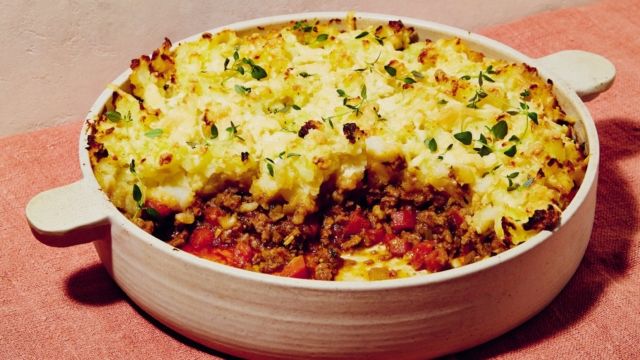A new book of smart shortcuts shows you don’t need to make meal out of cooking, writes Sophie Morris

Rosie’s shortcut shepherd’s pie (c) Louise Hagger
If a shortcut worked, the saying goes, it would simply be called “the way”. Perhaps, but I’m always happy to see “the way” evolve, especially when it brings us new hacks, our twenty-first century obsession with looking for smarter and speedier ways to complete everyday tasks.
In the kitchen, slowness is aligned with holiness. Taking your time is healthy, wholesome, sexy and sustainable. Fast food is the opposite: fatty, sloppy, a stopgap rather than a real meal. But with her new book The Shortcut Cook (Hardie Grant, £15), Rosie Reynolds wants to strip away judgemental assumptions about choosing the most direct route to a great meal.
“Lots of people find cooking stressful,” she says. “My whole approach is about making food better, but without the stress. Chefs and kitchen professionals have always used shortcuts to create great food. Home cooks have not always been allowed the same privilege and are often made to feel guilty about using certain tricks and ingredients. This book is about using shortcuts and creative solutions to get the best food.”
No shame
Should we be out and proud about shortcuts? “I wouldn’t turn my nose up at anything,” says Reynolds, “that’s not in my nature. I don’t think the kitchen should be a place of judgement. If buying a pre-chopped onion improves your kitchen experience, then go for it. Frozen fruit and veg can be economical, better in terms of taste, and save on food waste.”
When, in 2008, Delia Smith published How to Cheat at Cooking, her first book in five years, she was met with outrage from traditionalists who didn’t agree with her use of processed ingredients like tinned lamb mince and frozen mash. Some of the products she chose were criticised for being unhealthy, for example high in salt. But Delia was making the same point she had back in 1979, when she published the first version of How to Cheat at Cooking, her first cookbook: sometimes, we need to save time, and if the hack is good enough, then why not? Even Mary Berry is behind buying baked goods, and last Easter told BBC Radio 4’s The Food Programme she believes supermarkets have the best hot cross buns.
Layering flavours
Reynolds likes to build up the taste of a dish by layering ingredients for slow-cooked cheffy results. Her shepherd’s pie, for example, uses miso, soy and fish sauce to enrich the flavour, mimicking lamb that has simmered for hours rather than 20 minutes.
There’s useful information on the parts of recipes which can be made ahead. Eggs can be poached and quickly reheated, for example, a winner if attempting eggs benedict for a crowd, and hollandaise can be made in the microwave. She does roasts and entire fry ups on one oven tray. Sausages are put to work in a quick ragu and dauphinoise potatoes faked with creamy, cheesy, white beans – “all the glamour, none of the prep,” says Reynolds.
One pot
One-pot cooking might mean taking your time over a slow braise, but you can pull quick recipes together in a single pan, too. Plus it saves time on the washing up. In Alan Rosenthal’s Foolproof One-Pot, published last week (Quadrille, £12.99, published 18 February) there’s a chapter called “Throw it Together” which includes braised squid with preserved lemon, a lamb tagine, and a recipe for Boston baked beans which is only marginally more effort than opening a can.
“One-pot cooking isn’t just about convenience,” says Rosenthal. “The benefits go much deeper. They’re often incredibly comforting and heart-warming.” They’re not just for the cold months either; Rosenthal has recipes for herby pilaffs, seafood stews and a summery strawberry, lime and elderflower pudding.
“Modern Cook” Anna Jones also has a one-pot book out this month. One: Pot, Pan, Planet (Fourth Estate, £26, published 4 March) offers different kinds of shortcuts, with recipes which reveal how to cut back on food waste and get the best value for money.
“There’s nothing greater than feeding people, nourishing them, and enjoying the process,” says Reynolds. “It’s like giving someone a hug when you can’t have a real hug.”
Tips for quicker cooking from The Shortcut Cook by Rosie Reynolds, Hardie Grant, £15
- Gather everything before you start cooking: equipment, ingredients, a clean dish towel, etc.
- Have a large bowl or a plastic bag nearby for food waste, to keep your work station clean and clutter-free.
- Fill the sink with hot soapy water to keep your hands clean and to speedily wash up used or dirty bowls and equipment for quick re-use. Keep a clean cloth close by for wiping and some paper towels for patting, drying and draining foods.
- Start your cooking sessions by putting on the kettle – this will mean you can make up stock from cubes quickly, rinse out tins to add the liquid to sauces and stews, or get pasta on the boil much quicker.
- Make sure meat is not fridge-cold when you put it in the oven, as it will take a good 20–30 minutes to warm through before it can start cooking.
- Like meat, eggs need to come to room temperature before cooking. This will prevent them curdling cake mixes or being undercooked when boiled.
- Make dressing in the salad bowl you’re serving it in, then you won’t have an extra bowl to wash up.
- Finally, for washing away stuck-on grime use a little laundry washing powder – the detergent breaks down grease effectively and quickly.